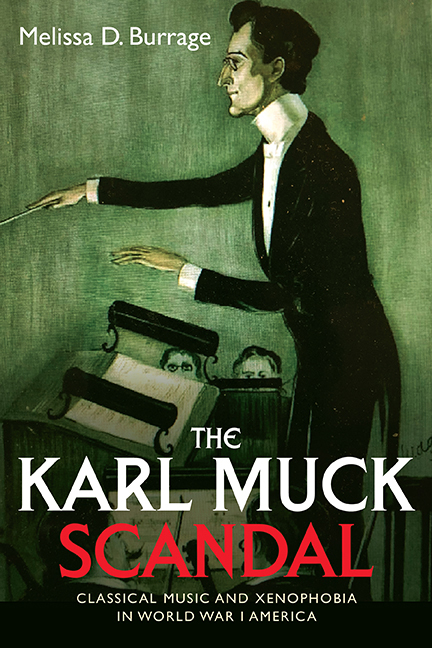Book contents
- Frontmatter
- Dedication
- Contents
- Introduction
- 1 Here on Foreign Shores: Dr. Karl Muck's Acclaim in Boston (1906–1918)
- 2 Mobilization: A Changing Environment for Boston (1917)
- 3 Selling the War: Demonizing the Enemy (1918)
- 4 “Looking for the Trump Card”: Mrs. William Jay's Attacks on Karl Muck in Wartime America (1915–1918)
- 5 “A Leaf in the Storm”: Muck, Higginson, and the Boston Symphony Orchestra (1918–1919)
- 6 Muck's Arrest: “Finding ‘One Weak Spot’” (1918–1919)
- 7 “Only Too Proud to Shoulder It All”: The Sexual Climate of Wartime Boston and Muck's Fall from Grace (1918–1919)
- 8 Muck's Final Years: His Association with the Wagners and Adolf Hitler (1920–1940)
- Coda (1919 to Present)
- Acknowledgments
- Notes
- Bibliography
- Index
- Eastman Studies in Music
3 - Selling the War: Demonizing the Enemy (1918)
Published online by Cambridge University Press: 06 September 2019
- Frontmatter
- Dedication
- Contents
- Introduction
- 1 Here on Foreign Shores: Dr. Karl Muck's Acclaim in Boston (1906–1918)
- 2 Mobilization: A Changing Environment for Boston (1917)
- 3 Selling the War: Demonizing the Enemy (1918)
- 4 “Looking for the Trump Card”: Mrs. William Jay's Attacks on Karl Muck in Wartime America (1915–1918)
- 5 “A Leaf in the Storm”: Muck, Higginson, and the Boston Symphony Orchestra (1918–1919)
- 6 Muck's Arrest: “Finding ‘One Weak Spot’” (1918–1919)
- 7 “Only Too Proud to Shoulder It All”: The Sexual Climate of Wartime Boston and Muck's Fall from Grace (1918–1919)
- 8 Muck's Final Years: His Association with the Wagners and Adolf Hitler (1920–1940)
- Coda (1919 to Present)
- Acknowledgments
- Notes
- Bibliography
- Index
- Eastman Studies in Music
Summary
Hardships Increase in Boston
On the morning of December 6, 1917, the French ship Mont Blanc approached Halifax Harbor in Nova Scotia and collided with the SS Imo, a six-thousand-ton Norwegian ship on route to Belgium to deliver relief supplies. The day was just beginning. Children were walking to school along the waterfront. Workers made their way to factories, offices, rail and dockyards. Hearing the commotion, those still inside their homes ran to their waterfront windows to witness the crash. The Mont Blanc, bound for France and filled with six million pounds of high explosives, erupted in a fiery blaze that heated its volatile cargo to nine thousand degrees Fahrenheit, turning the ship into a “monstrous hand-grenade,” sending chunks of metal projectiles from the disintegrating vessel outward in all directions at 3,400 miles per hour, puncturing nearby ships, slicing open rooftops, and vaporizing those in its path. The force of the blast caused a ground wave, or earthquake, penetrating the bedrock at 13,000 miles per hour, shaking homes off their foundations. The ferocious detonation produced a mushroom cloud, a giant gas fireball filled with vaporized particles, metal and human, that rose two miles in the air and threw into the atmosphere tons of dark oil that rained down on its victims, blackening their faces with a slimy tar. Air waves followed, traveling at 21,000 miles per hour and shattering almost every window in Halifax, shooting pieces of glass like knives into the eyes and bodies of those who stood watching. Within a second, onlookers were blind, riddled with glass shrapnel, or dead. Most buildings within a two mile radius were obliterated. The shock from the blast violently parted the harbor waters, forming a tidal wave, or tsunami, that engulfed inland streets, drowned inhabitants, and flooded buildings nearly sixty feet above sea level. In the final accounting, the explosion killed almost two thousand people and wounded nine thousand more. Twenty-five thousand people, almost half the population, were suddenly homeless. The thickly settled waterfront community that occupied more than three hundred acres looked like no-man's land—a war zone. Ruptured gas lines blew up additional structures, trapping many survivors in the rubble of their flattened homes. Trees and telephone poles were snapped at their bases. Cement and masonry structures were obliterated. Fires started everywhere, as wooden buildings acted like kindling fuel.
- Type
- Chapter
- Information
- The Karl Muck ScandalClassical Music and Xenophobia in World War I America, pp. 88 - 116Publisher: Boydell & BrewerPrint publication year: 2019



